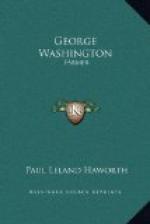And yet, by examining Washington’s accounts, one is able to estimate in a rough way the returns he received from his estate, landed and otherwise. We find that in ten months of 1759 he took in L1,839; from January 1, 1760, to January 10, 1761, about L2,535; in 1772, L3,213; from August 3, 1775, to August 30, 1776, L2,119; in 1786, L2,025; in 1791, about L2,025. Included in some of these entries, particularly the earlier ones, are payments of interest and principal on his wife’s share of the Custis estate. Of the later ones, that for 1786—a bad farming year—includes rentals on more than a score of parcels of land amounting to L282.15, L25 rental on his fishery, payments for flour, stud fees, etc.
Upon the average, therefore, I am inclined to believe that his annual receipts were roughly in the neighborhood of ten thousand dollars to fifteen thousand dollars a year from his estate.
As regards Mount Vernon alone, he sometimes made estimates of what the crop returns ought to be; in other words, counted his chickens before they were hatched. Thus in 1789 he drew up alternative plans and estimated that one of these, if adopted, ought to produce crops worth a gross of L3,091, another L3,831, and a third L4,449, but that from these sums L1,357, L1,394 and L1,445 respectively would have to be deducted for seed, food for man and beasts, and other expenses.
A much better idea of the financial returns from his home estate can be obtained from his actual balances of gain and loss. One of these, namely for 1798, which was a poor year, was as follows:
BALANCE OF GAIN AND LOSS, 1798
DR. GAINED CR. LOST
Dogue Run Farm 397.11.2 Mansion House ..
466.18. 2-1/2
Union Farm .... 529.10.11-1/2 Muddy Hole Farm
60. 1. 3-1/2
River Farm .... 234. 4.11 Spinning .......
51. 2. 0
Smith’s Shop .. 34.12.09-1/2 Hire of Head
Distillery .... 83.13. 1 overseer .....
140. 0. 0
Jacks ......... 56.1
Traveler ...... 9.17
(stud horse)
Shoemaker ..... 28.17. 1
Fishery ....... 165.12. 0-1/4 By clear gain on
Dairy ......... 30.12. 3 the Estate.....L898.16.
4-1/4
Mr. Paul Leicester Ford considered this “a pretty poor showing for an estate and negroes which had certainly cost him over fifty thousand dollars, and on which there was live stock which at the lowest estimation was worth fifteen thousand dollars more.” In some respects it was a poor showing. Yet the profit Washington sets down is about seven per cent. upon sixty-five thousand dollars, and seven per cent. is more than the average farmer makes off his farm to-day except through the appreciation in the value of the land. The truth is, however, that Mount Vernon, including the live stock and slaves, was really worth in 1798 nearer two hundred thousand dollars than sixty-five thousand, so that the actual return would only be about two and a fourth per cent.




